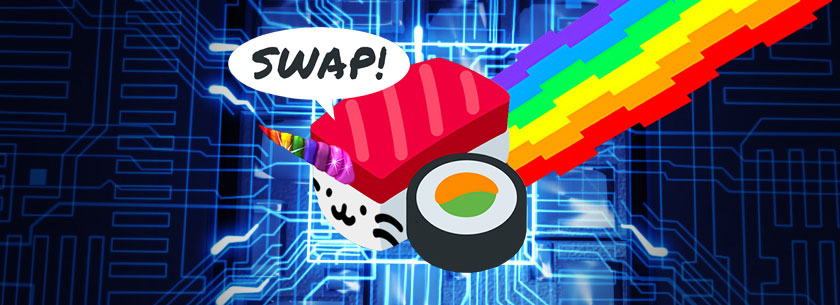
SushiSwap is a fork of Uniswap, which provides its users not only with the new SUSHI token and commission, but also the opportunity to participate in the management of protocols, as well as the choice of a strategy for further development. This distinguishes it from its predecessor, one of the most successful DeFi token exchange protocols on Ethereum, in which all decisions are made by the development team. In fact, we have a significant difference in the degree of decentralization, and with it - in overall reliability. But more on that later.
Introduction to the SushiSwap service
As the market for decentralized finance develops, more and more platforms are emerging that are directly related to it. Investors are attracted by both short-term lending services and platforms that allow them to “extract liquidity”, since all this allows them to make good money.
SushiSwap is a relatively new project in this area, which, just a few days after the official launch, received a capitalization of around $ 1 billion. Which, of course, made it an object of keen interest for investors from all over the world. How did he do it? Let's try to figure it out.
What is SushiSwap?
Before talking about the features of SushiSwap, you need to understand how its "predecessor" - Uniswap works. It is a decentralized exchange protocol that works without a single order book. Instead, it uses a model called "Automatic Market Maker" or "AMM". With it, liquidity providers add their funds to the general pool, and then receive some reward for this.
Actually, SushiSwap uses the same principle. But at the same time, it provides token holders not only part of the fees paid to the protocol, but also some rights to manage it. That is, instead of a group of developers, the direction of the protocol development and further improvements are determined by the community on the basis of a partially democratic principle. For any innovation, you can "vote with a ruble", or rather a token.
It was this high initial decentralization that attracted the attention of investors to the project. Equal initial conditions (In Uniswap, developers have the number of tokens necessary to dominate the decision-making process), lack of advantages for founders, voting rights depending on the amount of funds provided - all this encourages users to cooperate with this new service. A strong and active community is practically the guarantee of the successful existence of any blockchain project.
Uniswap or SushiSwap?
Yes, these projects are now definitely competitors for each other. On the side of Uniswap - reputation, relative stability and progressive introduction of innovations in the business of automatic market making. On the side of SushiSwap - greater compliance with the interests of community members, the effect of novelty, the experience of the mistakes of predecessors. Which of these is the most important for dominance in the sector is not yet known.
In any case, the emergence of such effective competitors reduces the effectiveness of Uniswap, which directly depends on the amount of liquidity in the pools. Therefore, a competitor may be in a better position not because it is objectively better, but because Uniswap's performance will deteriorate. And this has already happened - the separation of the new fork reduced the size of the basic liquidity pool by 3 times - by about 1 billion in dollar terms.
How exactly does SushiSwap work?
The core of the process is liquidity mining or "farming". First, users contribute their assets to certain liquidity pools, as a result of which they receive Uniswap LP tokens, which can then be added to the SushiSwap system using smart contracts and start earning SUSHI.
Initially, to stimulate this process, the SUSHI-ETH pool paid users double the reward. However, soon there were so many users that, as a result of a general vote, it was decided to add several more pools.
Safety
To begin with, SushiSwap still hasn't gone through a thorough audit, so the smart contracts used there may contain errors. However, serious steps in this direction have already been taken - a number of audit firms were involved, whose services the community agreed to pay for.
Some suspicions are raised by the fact that the creator of the project is unknown. He acts under the pseudonym "Chef Nomi". And it acts strangely. It is known that he withdrew all of his SUSHI tokens at one point, for a total of $ 14 million. Then, however, he returned these assets and apologized to the community. However, this deal seriously affected the price of the token and the confidence of users in its stability.
But the main problem with SushiSwap is the lack of a real base. The profit from them is not a full-fledged staking, which gives a real opportunity to influence the work of the blockchain, but a marketing move. SUSHI tokens are just another ERC-20 tokens that are only valuable within their platform. And as soon as investors cool off to the idea of "liquidity pharming" (and they will cool off, according to experts' forecasts, by the end of 2020), the SUSHI price will rapidly collapse, once again highlighting the opinion that DeFi is another "bubble".
So, most experts and investors agree that this project is a bold experiment, which, however, may fail. Therefore, you should not invest more in it than you are willing to lose.
In addition, the unhealthy excitement around a new way of mining liquidity has led to an overload of the Ethereum blockchain, and with it, to higher transaction costs. Which is not very useful for the decentralized finance ecosystem.
Conclusions
Despite a good start, SushiSwap is at the very beginning of its journey. Almost in the phase of "primary distribution of tokens". But whether they will be able to compete with Uniswap is a big question.
However, this experiment shows us how unstable the entire DeFi sector is and how easily “large” and “reliable” projects are deprived of their user support.




